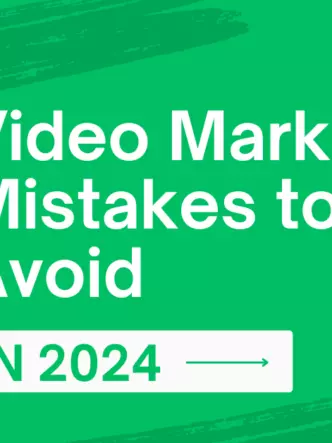The shift to creating more video content has been very noticeable over the past few years but creating good video content is only the beginning. You also have to plan how to host videos, manage them, enhance, and publish the videos in places where you can reach your intended audiences.

You also need to monitor and use video analytics to receive actionable insights on how to improve the videos.
Consumers prefer video over any other form of content and it can serve many business purposes but it is often difficult to incorporate video due to a lack of expertise and easy-to-manage tools to handle everything from creation to distribution.
This is where using a video hosting platform makes a difference by helping you achieve the best ROI with your videos and digital assets.
Create and manage digital content with a video hosting platform
Digital content management is easier when using the right video hosting platform. Hosting on free platforms like YouTube means you can reach many people with videos but there are a number of disadvantages that come with free hosting.
Constant recommendations for other videos on YouTube mean users can be distracted by videos on other channels. This is to done on YouTube to ensure that people remain on YouTube for as long as possible rather than going to your website.
On YouTube you can’t brand the video player with your logo or brand color.
Worst of all, companies and enterprises lose full control over video assets on YouTube. Opting to pay for hosting gives you complete control over your videos and digital assets.
Create digital content with video hosting site
You can create videos by using Cincopa’s RecTrace, a free Chrome extension that allows you to screen record personalized videos on any system.
Record your screen with or without webcam video and create videos for many different business purposes, from onboarding and training employees to making sales and offering customers better support.
Creating customizable video portfolios with video screen recorder means you can add them to your website and showcase videos to the right audience, share them across social media or even create dedicated video landing pages.
Edit and share videos with video hosting platform
You can edit and enhance your videos in a number of useful ways before you share them, such as adding a call-to-action or an email collector.
Copy the embed code for the video from the video hosting platform and paste it to where you want it to appear on your website.
When people play your video, the video is streamed from the video host’s servers as opposed to your server. This helps in reducing the lag time on your website and improves user experience when they are watching the videos.
Organize and protect your digital assets with secure video hosting
Instead of having a scattered collection of digital assets, it is important to organize digital assets so they’re easy to find and distribute.
A video hosting platform allows you to organize and protect your digital assets with digital asset management (DAM).
Your digital assets represent your brand and the statement it makes.
A great deal of time, money and effort goes into creating them and that is why it is so important to protect them. If your video and digital assets are not protected, they could fall into the wrong hands and this could affect the value of your business.
Difference between DAM Solution and a Video Solution Platform?

There are differences between Digital Asset Management (DAM) and Video Asset Management (VAM). Instead of choosing one or the other, partnering DAM and VAM together can maximize the performance of your digital assets.
Digital Asset Management (DAM)
Digital assets refer to any type of content that can be stored digitally.
Digital Asset Management (DAM) allows you to manage the whole digital asset lifecycle, serving as the central source of truth for all content, including images and documents.
DAM includes uploading, searching, and transforming functions for a broad array of digital assets. Without DAM, time is often wasted searching for files.
Using DAM means every asset’s metadata helps employees find exactly what they want. You can get more out of your images, video and other media when you ensure your teams can find, optimize and share digital assets in real-time.
Video Asset Management (VAM)
The core function for which DAMs were designed was for storing and sharing digital content.
The amount of computing power, storage and resources needed to manage video content is more than what is required for images and documents and this is where a video solution platform is necessary.
Today teams often work every day with large video and multimedia files.
Video asset management (VAM) is required to handle the large number of videos created by businesses.
Videos are harder to manage than other types of digital assets due to their audio-visual nature. They are much heavier in size and they need organized storage.
End-to-end VAM includes many capabilities, such as transcoding, indexing, search, sharing, analytics tracking, security, and much more.
How can partnering a Digital Asset Management Solution (DAM) with a Video Solution help enterprises?

Virtually every department in a business uses digital assets to help fuel its growth and success. Marketing teams create and collaborate on videos, emails, advertisements, and social media content.
Sales teams create videos that suit different stages of the sales funnel and encourage prospective customers to buy.
Other teams produce workflow diagrams, podcasts, videos etc., for internal communication and training. The customer services team may produce customer onboarding videos, FAQ videos etc.
A video hosting platform that includes digital asset management offers the most comprehensive solution.
For example, DAM systems often have limited capabilities for the modification and optimization of metadata and lack AI capabilities to provide in-video search. Finding a sentence in the hour-long video can be extremely frustrating.
VAM systems usually have extensive search capabilities with automatic transcription and auto-tagging.
There are four essential aspects to get the most out of digital assets when using a video solution and digital asset management –
-
Hosting
-
Management Enhancement
-
Publish
-
Monitor
1. Hosting
Your digital assets like your podcasts, videos etc., are large, complex files and hosting them on your own website is not advisable.
Hosting high-quality digital assets is a great drain on your storage space and server bandwidth. These assets will slow your website down and visitors will probably leave because they experience viewing difficulties, like buffering or freezing.
When you host your digital assets on the right video hosting site, you can easily manage your videos and share them across all browsers and devices without any difficulties.
You can share high-quality videos with 4K resolution and make use of unlimited storage and bandwidth.
2. Management Enhancement
Today teams have to store, organize, search and share digital assets. They can’t do this effectively if digital assets aren’t properly organized.
Managing all digital assets from one platform like a video hosting site simplifies the organization. It enables automation and streamlines workflows. Your teams can locate media assets easily with advanced search capabilities.
Anyone can share any digital asset at any time when needed. Here are feature an organization can use to optimize their digital assets with video hosting –
Customization: You can secure your brand by customizing your video player and protecting assets with watermarks.
Your video player looks more professional when you can add your own logo and use your company colors, change the player controls etc.
Integration: Easily embed videos in emails and marketing campaigns when your video hosting platform integrates with your other tools.
This helps you to improve your campaigns and boost your traffic with the opportunity to analyze engagement with video to optimize it and get more conversions.
Advertising tools and features to maximize video revenue: You can enhance your videos with many video features such as forms, email collectors and calls-to-action (CTAs) to drive consumers to take action, such as downloading an eBook or signing up for a newsletter.
Use video lead generation to capture emails so you can keep subscribers updated about your latest products, services or promo offerings.
Place advertisements pre-roll, mid-roll, or post-roll and you can allow viewers to skip watching after a few seconds. You have control over the placement, appearance and performance of advertisements.
With a video paygate, you can make some content available to authorized or premium viewers who have to subscribe and pay for content.
This is all possible with a video hosting site.
3. Publish
Embed videos on your website to engage viewers and enhance your video SEO with video hosting.
When you embed videos on your website, it has a positive SEO impact that helps you to increase your website traffic from search engines.
Create your own landing page (webpage)
It’s possible to build a highly customizable and fully responsive web page for your video, podcasts, images etc with Cincopa account site website and landing page builder.
You can publish multiple galleries and manage viewer access. The URL can point to a unique domain native to your brand, team or department, which helps to maintain brand unity for users.
Personalize and customize web pages with your brand identity. Manage your website and video audience with various security measures such as domain lock, email ids or password protection, so you get the right materials into the right hands.
Organization can also model their pages as per user funnel and use appropriate calls-to-action.
Content drives the customer experience and they expect personalized video that reaches them at the right time in their customer journey.
Teams need to seamlessly create and publish content customers want to see at various stages, such as explainer videos at the start and how-to videos at a later stage.
Use effective live streaming technology
By using the right live streaming technology, you can choose to stream one-to-many or run a full studio with multiple speakers.
Enterprises may want to live stream an event publicly or privately (from behind a login paywall) to maximize their profit and expose the business to a larger audience.
A transcoded stream means the content is converted on-the-go for more compatibility and a better user experience across networks and devices.
Save and enhance your live stream
Some video platforms auto-save your live stream to your media library. This means your feed is safe and you can enhance it with features like on-video annotations, ads, CTAs, subscription, multilingual subtitles, and more.
You can run a marketing campaign around your video content, embed it on your website, share it via a landing page, or share it on social media.
4. Monitor
Unless you can monitor your videos with video analytics and see who is watching them, how much they watch, as well as what devices and platforms customers are using, it is difficult to optimize them using the insights you receive.
See video stats presented in a graph, so you can see how they change in dynamics. Get information about each person who watches a video with a detailed viewing heatmap showing engagement rate with advanced video analytics.
You can also get information like the user’s location, average engagement, viewing time, platform, and IP address, as well as first and last view dates.
Actionable video analytics and video heatmaps allow you to understand your audience down to the individual view and measure engagement and KPIs.
You can identify key interest points and where viewers drop off. By generating these insights, you can improve video performance and user experience.
Importance of Video Asset Management (VAM) for internal communication

Managing videos from one video hosting platform can help with internal collaboration and sharing.
When video assets are stored in a central library, they are easy to retrieve, share and distribute.
Efficiently storing, organizing and managing videos is essential to decide what access each individual should have and to enable them to access the right videos at the right time.
There are many types of videos that can be shared internally – walkthrough videos, onboarding videos, training videos, troubleshooting videos, and project update videos.
Following are some of the actions an organization can take with Video Asset Management to enhance their internal communication –
Organizing your videos
Automatic transcription of videos enables using the transcripts for auto-tagging. Automating the use of naming conventions, like metadata and tags, makes it easier to organize many videos.
With VAM search filter functionality can be enhanced by assigning custom identifiers such as course titles etc. Search within a video allows viewers to find the exact moment to watch.
These features on a video hosting website can all drastically reduce the time it takes to find the right video.
Intelligent organization of a video library means videos can be used effectively in many areas of business. It means that enterprise will be able to share high volumes of video across many channels and to different devices quickly and reliably.
You can maximize your return on investment when you can find the right video at the right time and even specific elements within the video footage.
This will make marketing and sales teams more efficient because they can offer content to consumers based on where they are in the sales funnel to boost profitability. VAM helps you effectively manage your video assets with little to no effort.
Employees need to share information safely
The use of video for internal communication requires content protection measures due to the confidential nature of the information.
Security measures may be lacking when using DAMs alone, especially more traditional DAMs.
If you don’t adequately secure your videos, someone could embed them and drive traffic to their website rather than yours, benefiting from your traffic and conversions.
Video hosting platforms offer advanced security measures such as end-to-end encryption, role-based access controls, domain lock, password protection, and SSO.
Assigning user permissions prevents the information from falling into the wrong hands. SSO (single sign-on) is an authentication process where users need to enter a username and password to enter a secure video portal.
There are ways to bypass security settings, such as right-clicking and it is possible to disable a right-click menu to prevent downloads with secure video hosting. Domain whitelisting allows users to only embed a media player to specific domains.
It is possible to combine on-premise transcoding, data storage and efficient delivery inside your organization with a content delivery network (CDN).
Cincopa: DAM and VAM solution for your enterprise

With Cincopa, you can use your digital assets wherever you need them – on your website, in an email or on social media channels by embedding them directly from your dashboard.
You don’t have to worry about the quality of your videos as Cincopa has a content delivery network (CDN) which is a geographically distributed group of servers that work together to provide fast content delivery.
When a visitor on your site watches a video, it is served from a node nearest their location, ensuring a good viewing experience.
Global content delivery and adaptive bitrate streaming ensure great playback any time and from anywhere on all browsers and devices.
Cincopa can be integrated with many leading LMS platforms, popular eCommerce platforms, customer relations management and email management systems.
This enables you to utilize videos efficiently in a multitude of ways, such as inserting them in emails, using them for customer support or for learning purposes.
Conclusion
Organizing digital content in order to get the most out of it can be challenging.
Using Digital Asset Management and Video Asset Management system together can provide a comprehensive solution that offers the most return on investment (ROI).
Managing video is quite different from managing other forms of static digital assets due to the size and storage needs. It requires a system specifically designed to handle centralized storage, management, and playback of a large number of video assets and this is what a video hosting platform provides.
Help your business reach new heights without getting bogged down by problems with digital asset management, enhancement, publishing and monitoring by using a video hosting platform.









